How To Remove Stuck Shed On Leopard Gecko
Arguably the almost pop beginner'due south reptile, the leopard gecko has been available in pet stores for over 30 years as captive-bred specimens. Leopard geckos are friendly beginner reptiles, as they're docile, require little space for an enclosure, and are more often than not like shooting fish in a barrel to care for.
If y'all're looking to add a leopard gecko to your collection, we've got y'all covered. This article compiles all the information you'll need regarding leopard geckos and how to go on them.
Leopard Geckos (Eublepharis macularius) in the Wild
The leopard gecko'due south natural habitat ranges from Northeast Republic of india upward into the Middle E, in countries similar Pakistan, Iran, Iraq, and Afghanistan. They enjoy a semi-dry climate, living in arid desert scrub and dry forests. They make their homes on rocky structures, where they tin can bask on top and hide underneath.
Their leopard-like print is a naturally occurring design meant to part as cover-up in their natural environment and are shy lizards who like to hide from any sign of danger. When threatened, they will wag their tail methodically and drop it if necessary. Additionally, when food is arable, they can store fat in their tail, allowing them to hide for long periods of time when necessary.
Considering they are evasive past nature, leopard geckos tend to shed often in the wild every bit well as in captivity as they attempt to hide their scent from predators. When faced with danger, all the same, leopard geckos will bark, chirp, and hiss, making themselves seem more ambitious and less appealing to predators.
Agreement leopard geckos in the wild helps keepers understand the behaviors and habits of leopard geckos in captivity. While the bulk of leopard geckos available for purchase are captive-bred, this doesn't completely remove their wild behaviors, and leopard geckos volition still exhibit them when kept as pets. Using the information nosotros know about wild leopard geckos leads to more informed decision-making when keeping them in captivity.
Leopard Gecko Size and Appearance

Leopard geckos are relatively small-scale in size, with females being half dozen to eight inches in length when full grown and males being seven to 11 inches in length. While they are geckos, they are different from the wall-itch lizards you may be familiar with. Leopard geckos are terrestrial in nature, and equally such, their bodies differ from that of the common house gecko.
Leopard geckos have thick, triangular heads, with a clear separation betwixt their body and their tail. The body is, at times, thinner than their tail is, with thin limbs sprouting from the front and rear of information technology. The limbs have thin digits, unlike the sticky pads you see in business firm geckos. Leopard gecko tails tend to be thick and mesomorphic, as it'southward where the lizard stores its fat for times of food scarcity.
Aptly named for their about common pattern, leopard geckos appear to have leopard spots all along their body. They're most commonly yellowish with black or brown spots, but many other variations of colors, as well equally patterns, are available thanks to selective breeding.
These geckos that don't have their natural coloration or pattern are chosen morphs. Morphs tend to sell for more coin than their natural counterparts, with some being much rarer than others.
Leopard Gecko Lifespan
The lifespan of a leopard gecko in captivity can range from 15 to 20 years. When purchasing a leopard gecko, it is a long-term delivery and should be treated as such.
Leopard Gecko Enclosures

Dissimilar many other reptiles, leopard geckos don't need a large amount of space to be happy, and they don't need their enclosure to be smaller while they are hatchlings. One single gecko should be kept in a 30-gallon tank.
Enclosures can exist traditional glass terrariums or even opaque plastic storage bins, so long as the walls are at least 12 inches high. A secure screen should be kept on elevation of the enclosure to forestall any possible escapes.
One of the most of import aspects of a leopard gecko enclosure is the decor inside of it. Leopard geckos demand at least three hibernate boxes. Ane hide box needs to be filled with moist moss or vermiculite then that shedding can have place properly. Foliage can be added equally well, giving them semi-hidden areas to roam as well.
Substrate is another of import attribute for leopard geckos. Though their natural habitat consists of sandy landscapes, sand should be avoided in leopard gecko terrariums, every bit the consumption of information technology tin can pb to abdominal blockages. Suitable substrates include paper towels, aspen shavings, cypress mulch, or kokosnoot cobweb. Leopard geckos like to use the restroom in 1 corner of their enclosure in most cases, making cleanup like shooting fish in a barrel. Paper towels will need to be changed daily, while natural beddings can be spot cleaned every bit needed. In general, it is best to avert reptile rug every bit their nails may get snagged and come up off.
Leopard Gecko Lighting and Heating
As with many other reptiles, leopard geckos are temperature sensitive, and their enclosures need to exist ready up as such. Two bulbs will exist needed; a daylight basking bulb and a ceramic heating bulb for nighttime. The oestrus gradient for a leopard gecko should range from 75 to 90 degrees, allowing them to roam the enclosure to regulate their temperature properly.
Leopard geckos are entirely nocturnal, significant that they demand at least 12 hours without daylight to maintain a salubrious day and night cycle. To finer heat their enclosure at dark, the ceramic bulb can be used. However, if that'due south non effective at maintaining ideal temperatures, under-tank heating can be used instead.
Leopard Gecko Nutrition and H2o Needs
The diet of a leopard gecko is beginner-friendly as they only consume insects their unabridged life. Many other reptiles are omnivorous or are vegetarian with specific dietary restrictions. Leopard geckos will consume crickets, mealworms, waxworms, Dubia roaches, and minor hornworms. The dominion of pollex for feeding leopard geckos is based on the age of the gecko, every bit well as the size.
- Hatchlings up to half-dozen months in age should exist fed one insect a day.
- Juvenile geckos from six to 15 months should be fed ane insect every other day.
- Developed geckos should be fed every three days and should be offered an insect for every inch of gecko-body length (i.e., a six-inch gecko gets vi insects).
The insects should be gut-loaded 48 hours prior or dusted prior to feeding with a calcium and D3 vitamin supplement each time they swallow. This ensures that the cadger is getting the necessary nutrition from their meals.
A water bowl should be kept in one area of the enclosure that an entire gecko can fit in only does not let for a h2o level above their ears. This provides the humidity that leopard geckos need in their enclosure, equally well equally a place to soak and absorb h2o when needed. Make sure the water dish is not under a oestrus lamp.
Leopard Gecko Beliefs
Leopard geckos are unlike many other reptiles as they alive communally in the wild likewise equally in captivity. Leopard geckos are very territorial, and if at that place is more than one in an enclosure, they will more than than likely fight relentlessly.
In the wild, leopard geckos spend the majority of their time climbing or burrowing, and their captive environment should provide areas to climb in the very least, though a thick layer of substrate for burrowing is preferred equally well.
Most all leopard geckos' activities volition occur at night. This includes hunting and vocalizing. Every bit such, leopard geckos demand to exist fed at night and immune to roam their tank. As such, they should most likely not be kept in bedrooms, every bit their vocalization and scurrying can go quite loud.
Leopard Gecko Handling

Treatment a leopard gecko tin be done and can provide the reptile with a good amount of enrichment. As such, at that place are practices that need to be put into place when treatment them. They are able to drib their tails if threatened, so picking up a leopard gecko by their tail is something that must never be done.
Additionally, they like to climb, and then when handling them, walk them using the hand-under-hand technique. This allows for enough of climbing and enrichment outside of the enclosure.
Leopard Geckos: The Perfect Beginner Reptile
If you're looking to dive into keeping reptiles, beginning with a leopard gecko is a solid choice. They're hardy lizards that live for 15 to twenty years in captivity and take very basic requirements when compared to other reptiles. Go a leopard gecko or several; you lot won't be disappointed.
SOURCES:
Leopard Gecko Care Canvass and Starting time-Time Owners Guide | Everything Reptiles
Leopard Gecko Care Canvass | Reptiles Magazine
How Gut Loading Works | The Spruce
Source: https://www.reference.com/pets-animals/leopard-gecko?utm_content=params%3Ao%3D740005%26ad%3DdirN%26qo%3DserpIndex&ueid=172d62d2-4ebf-4169-a37e-11a030b3a5c7

0 Response to "How To Remove Stuck Shed On Leopard Gecko"
Post a Comment